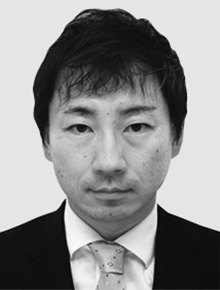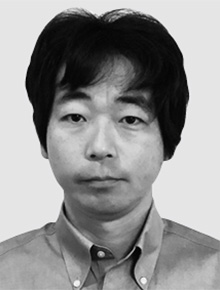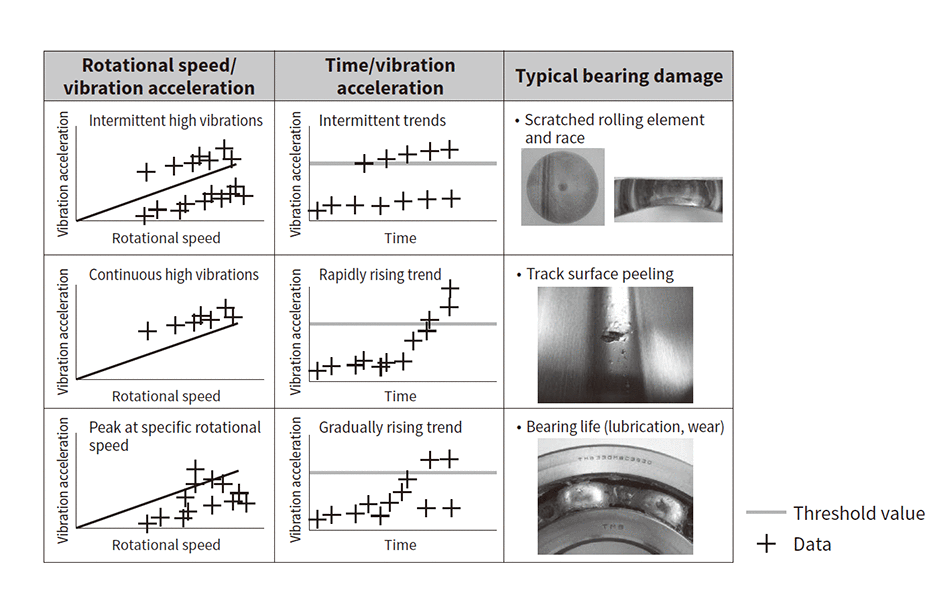OverviewMultipurpose Deployment of Highly Efficient and Reliable Industrial Electric MotorsCore Utility Products Underpinning the Social Infrastructure
Highlight
Motors are the Hitachi’s founding products and have come a long way since that time through advances in design and manufacturing technologies backed by a long tradition. This article presents Hitachi’s lineup of highly efficient and reliable industrial electric motors that are made possible by these technologies, and are installed in machinery used for various applications. Hitachi’s lineup of motors for rail transport includes compact, high-efficiency induction motors and permanent magnet motors made possible by applying electromagnetic field/thermal-structure multiphysics analysis, optimization technology, and materials technology. This article also looks at the work being done on predictive diagnosis for industrial electric motors that make use of Lumada, a Hitachi solution designed to accelerate the pace of digital innovation. The discussion is illustrated by examples of equipment diagnosis using motor inverter signals, and diagnosis of bearings in wind power generators.
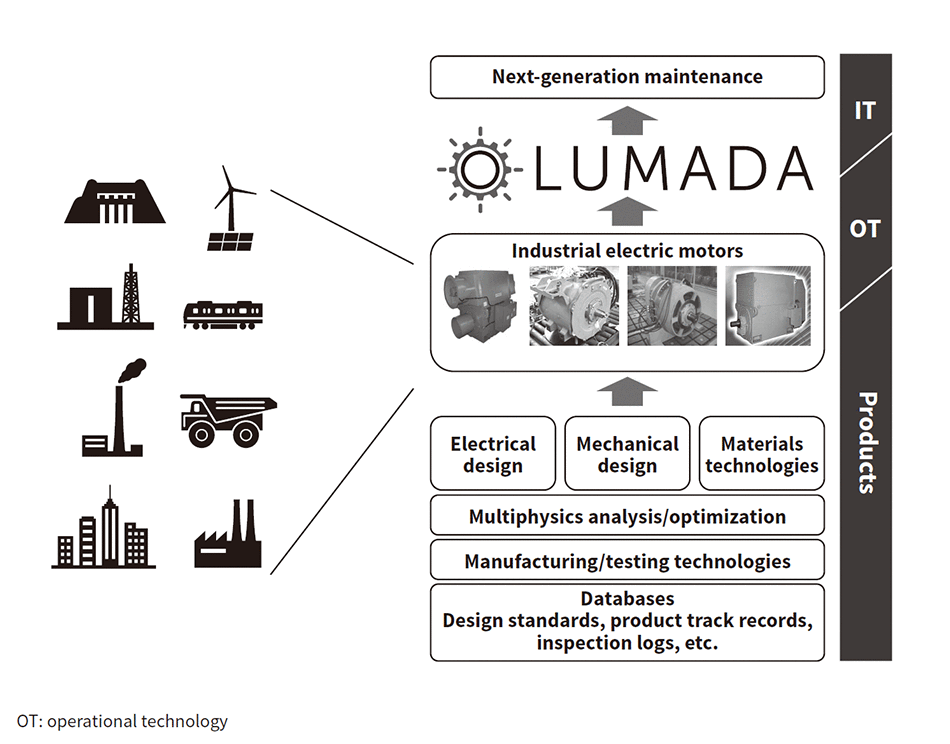
1. Introduction
Fig. 1—Design Concept of Lumada-based Industrial Electric Motors Providing High Efficiency and Reliability By bringing digital technologies together with Hitachi’s design and manufacturing technologies (IT and OT), these industrial electric motors provide new value from benefits such as reducing maintenance costs while maintaining product reliability throughout the entire lifecycle.
By bringing digital technologies together with Hitachi’s design and manufacturing technologies (IT and OT), these industrial electric motors provide new value from benefits such as reducing maintenance costs while maintaining product reliability throughout the entire lifecycle.
Motors are the Hitachi’s founding products and have come a long way since that time through advances in electrical and mechanical design, materials technologies, and manufacturing and testing technologies backed by a tradition spanning over a century. As a result, Hitachi motors have become key devices underpinning the social infrastructure. Its industrial electric motors are used for a wide range of applications, with uses that have spread to areas such as power generation, industry, mobility, and home appliances(1). Alongside work on refinements to today’s Internet of things (IoT) and digital technologies, Hitachi is now working on developing diagnostic technology that analyzes actual product operation information and predicts equipment replacement dates by using Lumada (a Hitachi solution designed to accelerate the pace of digital innovation)(2), (3).
Hitachi’s motor design and manufacturing technologies are bringing together products and digital technologies in a way that lowers maintenance costs while maintaining product reliability throughout the entire product lifecycle from design to operation and maintenance. This article presents industrial electric motors that create new value by applying the latest motor design technology together with the IoT and digital technologies (see Figure 1).
2. Highly Efficient and Reliable Industrial Electric Motors
This section presents typical examples of Hitachi’s industrial electric motors, looking at the latest motor technologies being incorporated into rail transport systems and mining dump trucks released in markets throughout the world.
2.1 Motors for Rail Transport
The recent growth in worldwide concern for the environment is creating a need for more energy-saving rolling stock drive systems, and there is increasing demand for ways of reducing maintenance work to adapt to today’s shrinking workforces. Rolling stock traction motors have seen a major shift from direct current (DC) motors to induction motors that has been accompanied by efforts to increase performance and efficiency while reducing size, weight, and maintenance needs. The technologies used to address these issues are presented here.
In 1998, Hitachi developed a low-maintenance rolling stock traction motor with a filterless dust extraction mechanism (filterless low-maintenance motor) that greatly reduces the maintenance workload by providing a number of benefits. For example, it eliminates the need for air intake filter cleaning, reduces the internal traction motor dust cleaning workload, and reduces the frequency of traction motor disassembly work. In response to demands for further gains in noise reduction and energy-saving, the company subsequently began work on developing a 165 kW totally enclosed induction motor in 2003. After repeated work on prototype verification testing, a 190 kW totally enclosed induction motor was developed in 2009 and released in 2012. To date, the company has delivered over 20,000 filterless low-maintenance motors and over 1,300 totally enclosed structures [see Figure 2 (a)].
Hitachi’s past development work has improved the rated efficiency of traction motors by about 95%. Since obstacles such as restricted railroad truck mounting space make it difficult to achieve further efficiency gains just by refining conventional designs, permanent magnet synchronous motors (PMSMs) are increasingly being used alongside conventional induction motors (IMs) as way to achieve these efficiency gains. IMs and PMSMs each have their own advantages for use in rolling stock systems. IMs enable a single inverter to control multiple motors, resulting in superior drive system compactness and cost. PMSMs control a single motor with a single inverter, resulting in advantages such as better viscous control performance when idling. Since PMSMs have high standalone motor efficiency, they also provide better power consumption on lines with short coasting intervals due to frequent station stops. In contrast, IMs are better on lines with many coasting intervals due to infrequent station stops, where no losses are generated from coasting. But IMs require further efficiency gains to handle system configuration and maintainability issues. Hitachi has responded by working on improving IM efficiency and releasing PMSM models. This work has led to product releases.
IM losses consist of copper loss, iron loss, mechanical loss, and stray load losses such as harmonic losses. The copper and iron losses are generated by fundamental frequency components (sine wave components), and the mechanical loss by mechanical factors during IM operation. Harmonic losses include losses caused by the IM’s structure and losses caused by the inverter waveform. Reducing the copper and iron losses has always been the main method of improving IM efficiency, and has been responsible for reducing loss by about 30%. In addition to this improvement, harmonic loss has been reduced by about 80% by using electromagnetic field analysis to analyze the magnetic flux distribution within the motor in detail and developing a rotor structure that reduces both harmonic loss caused by the IM structure and harmonic loss generated during inverter drive (see Figure 3)(4), (5). To make further efficiency gains, elements such as low-loss electrical steel sheets, trapezoidal bars, and magnetic wedges have been used to attain commercial efficiency (efficiency by summation of losses) of about 97%, reduce loss during inverter drive, and reduce loss by about 63% relative to conventional IMs (see Figure 4)(6).
To increase PMSM efficiency, multipolarization has been used to shorten stator winding coil lengths and reduce copper loss. High-speed side efficiency has been increased by improving the power factor by using asymmetrical magnetic poles in the skew structure needed to improve motor control performance [see Figure 2 (b)]. These refinements have improved commercial efficiency to about 98% (a figure exceeding IMs) while using a totally enclosed body structure with the same weight as an open structure.
Fig. 2—Hitachi Traction Motors for Rolling Stock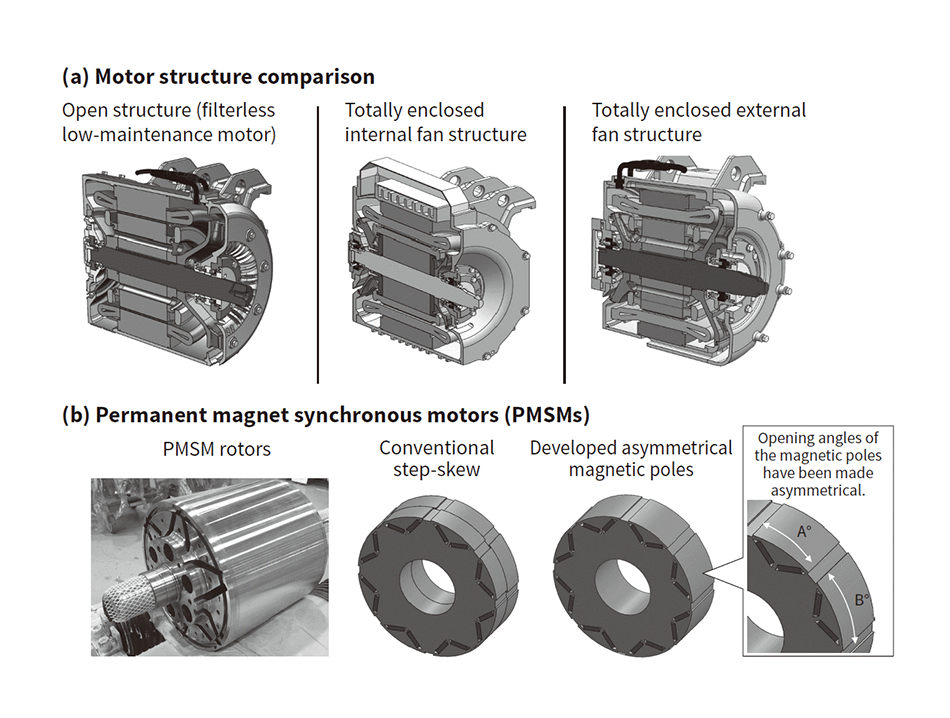 Use of a totally enclosed structure has reduced internal dust and improved maintainability relative to conventional open structures. PMSM models have also been released that use asymmetrical magnetic poles to reduce pulsation loss.
Use of a totally enclosed structure has reduced internal dust and improved maintainability relative to conventional open structures. PMSM models have also been released that use asymmetrical magnetic poles to reduce pulsation loss.
Fig. 3—Motor Loss Composition and Harmonic Loss Reduction Technology Motor efficiency has previously been increased by reducing the copper and iron losses. Losses during inverter drive have also been reduced by focusing on harmonic losses and using electromagnetic field analysis to break down the motor’s internal magnetic flux into its factor components, enabling use of optimized structures adapted to the loss generation mechanisms.
Motor efficiency has previously been increased by reducing the copper and iron losses. Losses during inverter drive have also been reduced by focusing on harmonic losses and using electromagnetic field analysis to break down the motor’s internal magnetic flux into its factor components, enabling use of optimized structures adapted to the loss generation mechanisms.
Fig. 4—Comparison of Losses in Conventional and High-efficiency IMs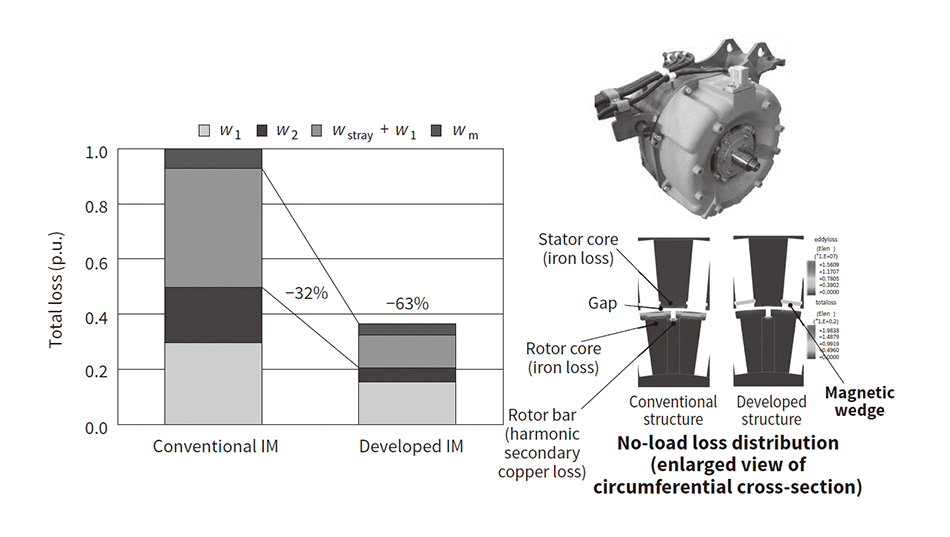 Relative to conventional IMs, the high-efficiency IM developed by Hitachi reduces iron loss and stray load loss by a combined total of about 32%. Total loss overall is reduced by about 63%. Refinements such as use of magnetic wedges to reduce surface loss enable efficiency of 96.8%, which is a level of efficiency nearly equal to a PMSM.
Relative to conventional IMs, the high-efficiency IM developed by Hitachi reduces iron loss and stray load loss by a combined total of about 32%. Total loss overall is reduced by about 63%. Refinements such as use of magnetic wedges to reduce surface loss enable efficiency of 96.8%, which is a level of efficiency nearly equal to a PMSM.
2.2 Traction Motors for Mining Dump Trucks
Fig. 5—Equipment Installed in Mining Dump Trucks Hitachi has drawn on technologies and expertise accumulated over many years in traction motors for rolling stock to develop traction motors and generators that are compact and highly efficient, ensuring high reliability supporting use in harsh environments. To maintain accurate operation in mine hauling environments with continuously changing road surface conditions, actual load testing is performed on traction motor and control equipment combinations in the plant.
Hitachi has drawn on technologies and expertise accumulated over many years in traction motors for rolling stock to develop traction motors and generators that are compact and highly efficient, ensuring high reliability supporting use in harsh environments. To maintain accurate operation in mine hauling environments with continuously changing road surface conditions, actual load testing is performed on traction motor and control equipment combinations in the plant.
Mining dump trucks drive and control the traction motor by using a converter/inverter for DC into alternating current (AC) conversion of power generated by a diesel generator. This technology is an application of systems used in equipment such as diesel electric locomotives (DELs) for rolling stock. Traction motors used in mining dump trucks need high hauling performance along with stable operation in a wide range of temperature environments ranging from equatorial to polar. By drawing on technology and expertise gained over many years of working on traction motors for rolling stock, Hitachi’s dump truck traction motors enable compact designs and high efficiency, while ensuring the reliability needed to withstand harsh environments. Mining dump trucks with Hitachi traction motors are currently in use around the world at a growing range of sites in countries such as Australia, Republic of South Africa, Republic of Zambia, Republic of Mozambique, Republic of Finland, USA, Canada, Russian Federation, China, and Republic of Turkey.
One recent example of a development project is the verification testing now being done in Australia for an autonomous haulage system (AHS) used in mining dump trucks. Ensuring that control commands tailored to the current conditions are correctly communicated to the traction motor and used to drive it are increasingly important requirements for supporting self-driving vehicles. Hitachi is continually working to improve the controllability of traction motors and control equipment so that they can maintain accurate operation in mine hauling environments where changes in road surface and other conditions are extreme and continuous (see Figure 5).
3. Use of Lumada to Improve the Value of Industrial Electric Motors
This section looks at new Lumada-based methods of maintaining industrial electric motors, including some of the latest examples now underway. Lumada is a Hitachi solution designed to step up the pace of digital innovation through work on refining IoT and digital technologies.
3.1 Equipment Diagnosis Using Inverter Signals from Motors Mounted in Equipment
Fig. 6—Industrial Inverter and Motor Lineup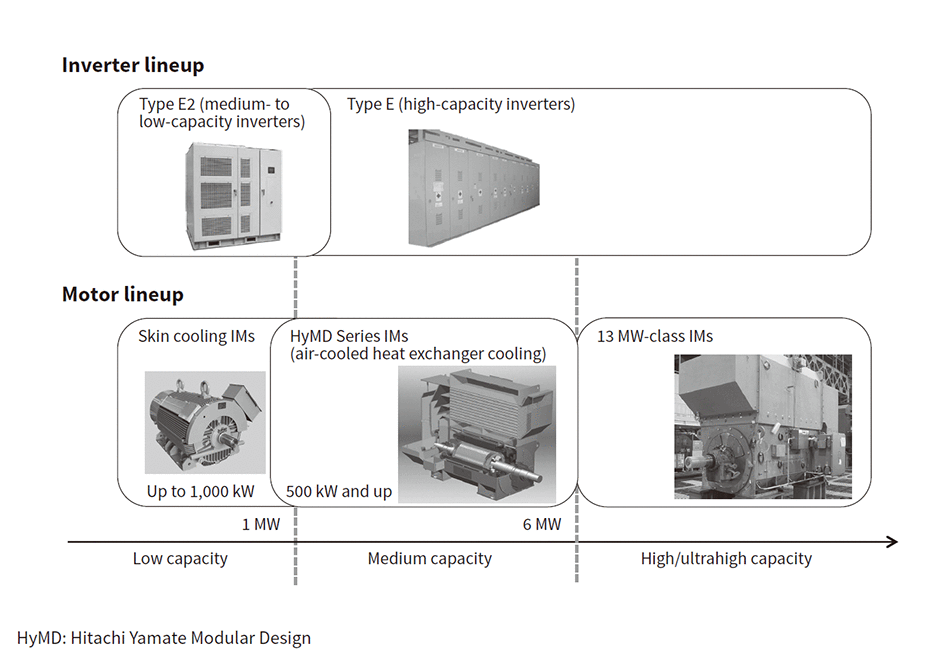 Hitachi is improving customer value worldwide by drawing on experience accumulated over a century of motor manufacturing, along with cutting-edge motor control technologies and an extensive lineup.
Hitachi is improving customer value worldwide by drawing on experience accumulated over a century of motor manufacturing, along with cutting-edge motor control technologies and an extensive lineup.
Fig. 7—Overview of IoT-based Industrial Electric Motor Drives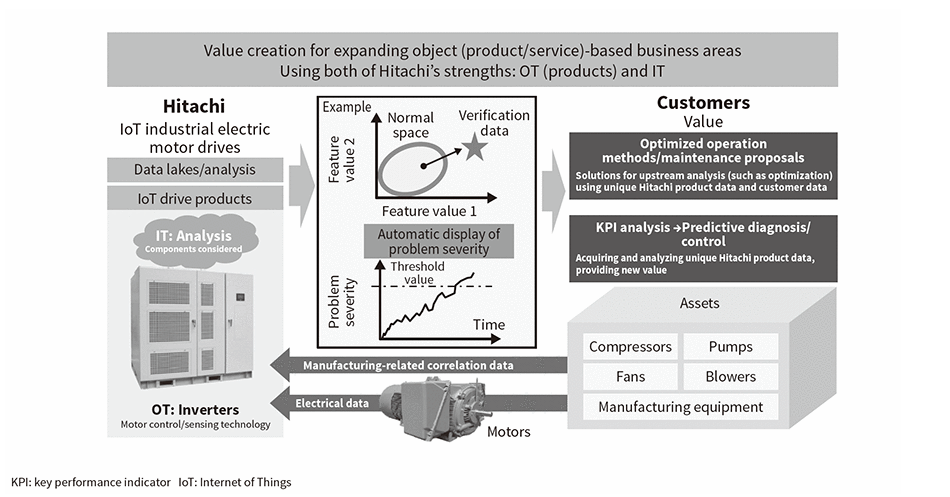 Hitachi’s IoT-based industrial electric motor drives use the motor as a sensor to gather current, voltage, and various other types of electrical data. They perform real-time equipment and machinery KPI analysis, predictive diagnosis and control. Gathered data is used to provide guidelines for areas such as optimum operation methods.
Hitachi’s IoT-based industrial electric motor drives use the motor as a sensor to gather current, voltage, and various other types of electrical data. They perform real-time equipment and machinery KPI analysis, predictive diagnosis and control. Gathered data is used to provide guidelines for areas such as optimum operation methods.
Figure 6 shows Hitachi’s lineup of industrial motors and inverters as of November 2019. To provide an example of the new value that Hitachi is providing to customers, this section presents a Hitachi equipment diagnostic solution made possible by industrial electric motors and inverters that bring new added value to the lineup. Hitachi is currently developing an IoT-based industrial electric motor drive that detects key performance indicators (KPIs) such as motor, equipment, and machinery problems and quality. It also performs predictive diagnosis, provides control, and suggests optimum operation guidelines. These features are made possible by combining electrical signals and control information obtained from a Hitachi inverter by using the motor driving the equipment and the machinery as a sensor (see Figure 7). This drive also supports non-Hitachi inverters if a sensor is mounted. However, the use of Hitachi inverters eliminates this additional sensor and provides other benefits such as access to internal inverter information.
As shown in Figure 7, the solution uses the motor as a sensor to collect electrical data, and can also use data from the customer if needed. The required parameters are selected from among the data to extract feature values for correlation analysis and model building. These models are used for objectives such as providing real-time displays of changes of the degree of anomaly against the motor, equipment, or machinery, and identifying problem locations. The correlation analysis with customer KPI data is also used to prevent equipment problems or quality issues.
These methods are already in use at multiple sites. The solution aims to let the company evolve beyond the simple Hitachi product delivery business model of the past by providing a deeper level of value through collaborative creation work with customers. This approach will let the company provide equipment diagnosis and other forms of new added value through industrial electric motor drives that draw on Hitachi’s operational technology (OT), IT, and products.
3.2 Wind Power Generator Bearing Diagnosis
Fig. 8—Wind Power Generator Lineup and Specifications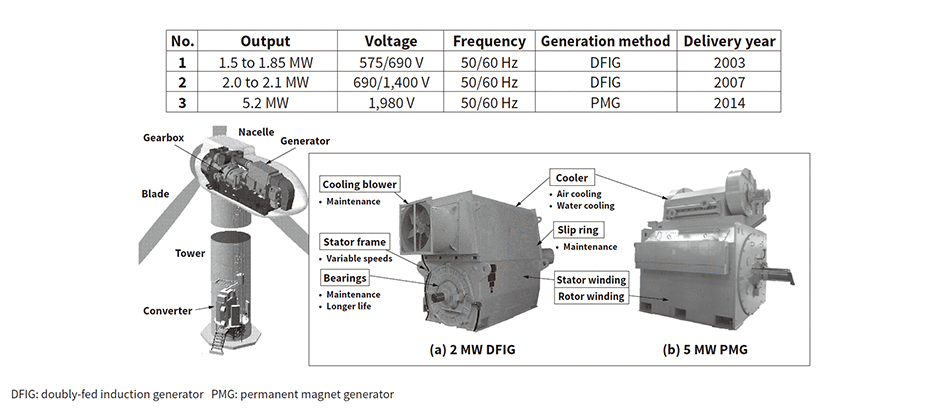 Shown here is the lineup of generators manufactured and delivered by Hitachi. Hitachi has delivered a total of about 10,000 units to date.
Shown here is the lineup of generators manufactured and delivered by Hitachi. Hitachi has delivered a total of about 10,000 units to date.
Fig. 9—Development of Wind Power Generators Using Actual Equipment Data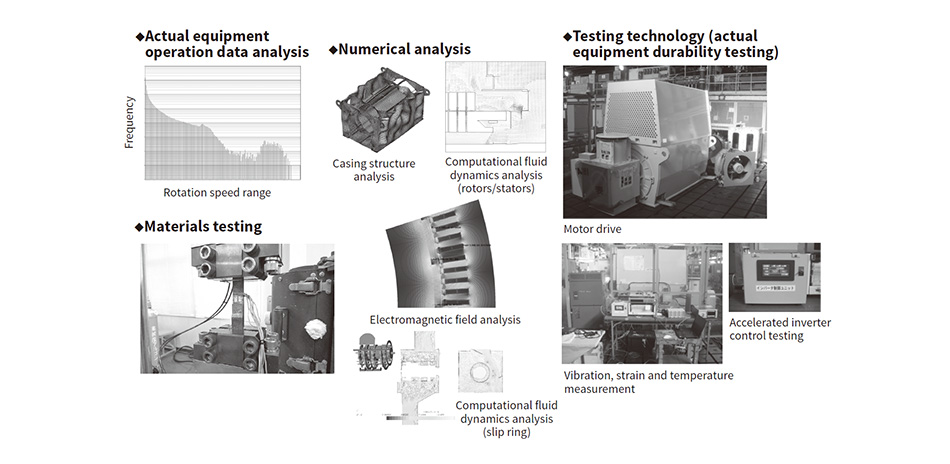 Wind power generators undergo optimized design and verification testing using various types of analysis done during the design phase. Hitachi has recently been improving its ability to use actual equipment operation data acquired online as feedback for design and testing.
Wind power generators undergo optimized design and verification testing using various types of analysis done during the design phase. Hitachi has recently been improving its ability to use actual equipment operation data acquired online as feedback for design and testing.
Wind power generation systems are playing a key role in the shift toward renewable energy sources. Hitachi has developed various wind power generators that draw on motor and generator technologies accumulated over many years, and has logged an extensive track record of generator deliveries to domestic and overseas customers.
Figure 8 shows Hitachi’s wind power generator lineup. The lineup is divided into AC excitation types and permanent magnet types. Both are totally enclosed types with coolers. Numerical analysis has been used to ensure appropriate aeration cooling design and compactness. Elements such as stator frame structures have been designed to withstand vibrations by considering changes in rotation speed caused by wind speed. The bearings have been designed for lower maintenance and longer life. AC excitation types have a slip ring for rotor winding excitation. The brush unit components requiring maintenance have been given highly reliable structures made possible by techniques such as computational fluid dynamics analysis. A highly reliable Hitachi insulation system, made of mica, has been used to withstand extended operation under harmonic voltages from the excitation converter(7).
Wind power generators undergo optimized design and verification testing involving various types of analysis done during the design phase. The load environment of wind power generators can sometimes be different from the anticipated environment as wind conditions at the installation site change. Hitachi has therefore created methods of analyzing operation data from actual equipment, and methods of numerical analysis and verification testing. Figure 9 shows an example of how actual equipment operation data acquired online by the supervisory control and data acquisition (SCADA) system, provided as standard equipment in Hitachi wind power generators, is fed back to design using numerical analysis/materials testing, and product reliability is verified using accelerated durability testing in the manufacturing plant. Using and analyzing the data acquired from the SCADA system lets the wind power generator detect generator bearing degradation and its progress early on, providing a solution enabling bearing replacement or repair before power generation is shut down by bearing damage. The technical expertise Hitachi has accumulated over its history is used to pinpoint the optimum sensor set from among 200 items of statistical information, while the company’s wind turbine operation expertise is used to evaluate the progress of correlation breakdown among sensors to predict generator bearing damage (see Figure 10)(3).
Predictive diagnosis is also done by analyzing trends among the bearing vibration acceleration data from the standard mounted sensors. As shown in Figure 11, bearing damage is detected using a system that visually depicts the relationship between bearing acceleration and rotation speed, and the changes in vibration acceleration over time. The results enable simple evaluations of changes in vibration characteristics over time, suitable for rapidly evaluating bearing damage. When bearing damage is difficult to evaluate using the vibration sensors provided as standard equipment, temporary vibration sensors are sometimes mounted to measure the characteristic frequency of the bearings. The acquired data is compared to the inspection results logged when the bearings were maintained, to acquire correlation data used to improve the problem detection accuracy (see Figure 12).
Wind power generator bearing diagnosis enables early detection of problems in bearing units by using multiple detection methods like the methods covered here. It enables parts for repairs to be obtained in advance, early scheduling of workers, and repair proposals aligned with turbine maintenance. Hitachi wants to draw on these benefits to provide customers with wind power generators that reduce turbine downtime.
Fig. 10—Predictive Diagnosis for Wind Energy Generation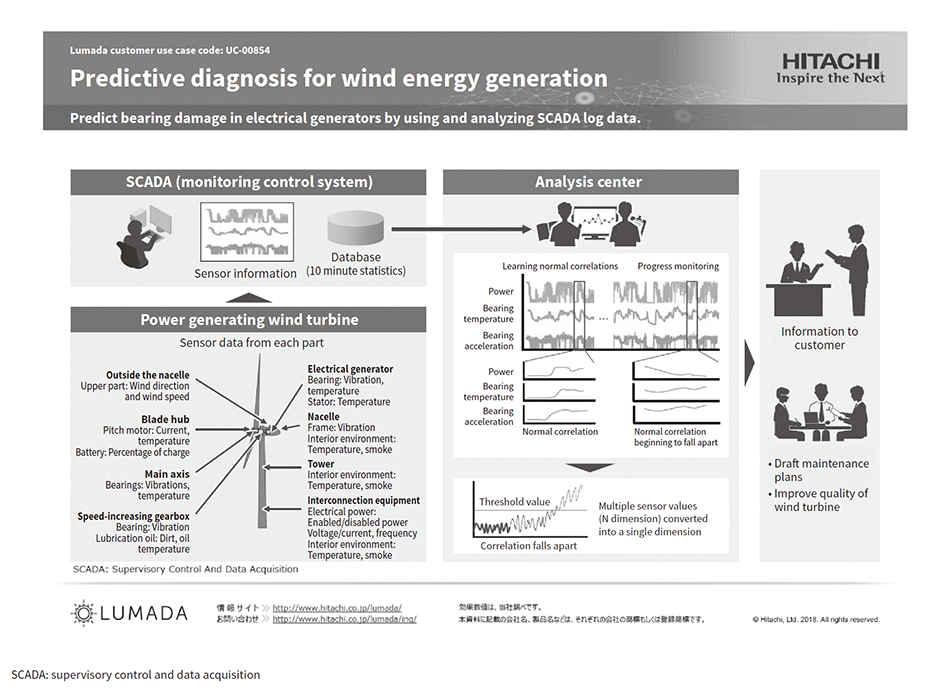 Data acquired from the SCADA system can be used and analyzed to enable early detection of generator bearing degradation and its progress. The progress of correlation breakdown among sensors is evaluated to predict generator bearing damage.
Data acquired from the SCADA system can be used and analyzed to enable early detection of generator bearing degradation and its progress. The progress of correlation breakdown among sensors is evaluated to predict generator bearing damage.
Fig. 11—Bearing Vibration Trend Analysis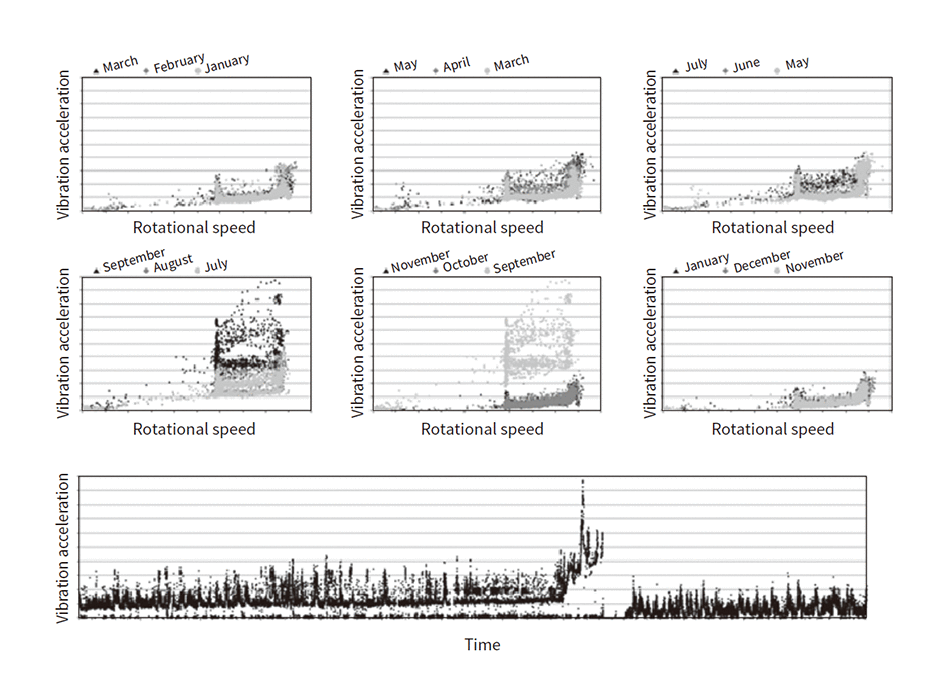 Bearing damage is rapidly evaluated from the signals of vibration sensors provided as standard equipment. The evaluation is made possible by a system that visually depicts the relationship between bearing acceleration and rotational speed, and the changes in vibration acceleration over time.
Bearing damage is rapidly evaluated from the signals of vibration sensors provided as standard equipment. The evaluation is made possible by a system that visually depicts the relationship between bearing acceleration and rotational speed, and the changes in vibration acceleration over time.
4. Conclusions
Hitachi’s industrial electric motors are made possible by motor design and manufacturing technologies backed by a long tradition, and are used in a wide range of applications underpinning the social infrastructure. By bringing product design and manufacturing experience together with digital technologies, Hitachi is now becoming increasingly adept at providing added value from areas such as new maintenance methods in the form of equipment diagnosis that draws on Hitachi’s OT, IT, and products. The company will continue to incorporate best practices into its product lineups, working to improve customer value.
REFERENCES
- 1)
- H. Mikami et al., “Historical Evolution of Motor Technology,” Hitachi Hyoron, 92, pp. 928–933 (Dec. 2010) in Japanese.
- 2)
- N. Takeda et al., “Using Operation Information in Reliability Design and Maintenance: Analytics for the IoT Era,” Hitachi Review, 65, pp. 450–455 (Nov. 2016).
- 3)
- Hitachi, Ltd., Lumada: Customer Cases, “Predictive Diagnosis for Wind Energy Generation,”
- 4)
- S. Sugimoto et al., “Study on Decreasing Time and Space Harmonic Losses of Induction Motor,” The Institute of Electrical Engineers of Japan, Transactions on Industry Applications, 135, 10, pp. 993–998 (Oct. 2015) in Japanese.
- 5)
- K. Ishikawa et al., “Development of Rolling Stock Inverters Using SiC,” Hitachi Review, 66, pp. 155–160 (Feb. 2017).
- 6)
- K. Terasawa et al., “Development of Lightweight Traction Systems to Reduce Energy Consumption,” Hitachi Review, 67, pp. 802–807 (Dec. 2018).
- 7)
- M. Iizuka, “Generators and Motors for Large and More Advanced Models,” Wind Energy, 34, 4, pp. 8–11 (2010) in Japanese.

